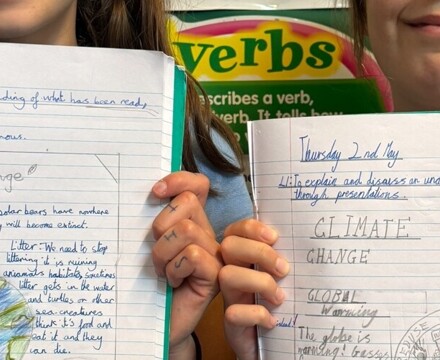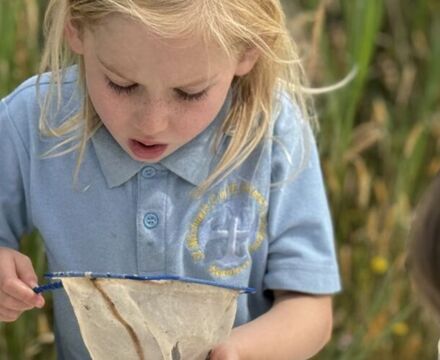Geography
Intent
Through the teaching of geographical skills, knowledge and understanding, pupils better learn about the interaction of human beings with their environments at a variety of scales from local to global. At St Michael’s C of E Primary Academy, our geography curriculum will engage and motivate children to see the world through the eyes of young geographers.
We will deliver a curriculum that:
• Inspires a curiosity and fascination about the world and its people
• Equips children with an understanding of diverse places, people, resources and environments around them
• Allows children to build on prior learning about physical and human processes and the formation and use of landscapes and environments
• Develops an understanding that the Earth’s features are interconnected and change over time
• Encourages exploration of their own environment and challenges pupils to make connections between their local surroundings and that of contrasting settlements
• Uses the local area and community as well as the wider world to develop geographical skills and knowledge
• Sequentially builds upon children’s basic geographical knowledge.
Implementation
The teaching, learning and sequencing of the geography curriculum is as follows:
• The ‘Connected Curriculum’ is implemented to ensure coverage and progression in all skills and knowledge relating to geography. Moreover, there is an opportunity within each session to revisit geographical skills that need further consolidation and to use new knowledge to enforce prior skills
.• Educational visits to enhance their cultural capital and where applicable links to geography will be made to develop the children’s topical learning
• A geography progression of skills that is organised into the following main themes based on the geographical association recommendations: locational knowledge, place knowledge, human and physical knowledge and skills and fieldwork for each year group
• Throughout Key Stage 1 we challenge and support our children to carry out geographical investigations which enable them to use and apply appropriate subject vocabulary, subject tools (including maps, aerial photographs and graphical data and fieldwork skills) to recognise, identify, describe, observe, reason and begin to explain in simple terms the interaction of people with their environments
. • Through Lower Key Stage 2 (Years 3 and 4), geographical learning and teaching builds on the knowledge and understanding, skills and outcomes at Key Stage 1, and the pupils are encouraged to reach explanations and conclusions about topics, places and issues they have studied. Pupils are expected to base their understanding on data they have collected. Pupils will also begin to be able to see the world through the perspective of different stakeholders i.e. people and things that have an interest in or are connected to an issue or place.
• At Upper Key Stage 2 (Years 5 and 6) pupils will focus big questions that extend the children’s subject skills so that they are able to make judgements about things they learn both from their own personal perspective and through empathising with the position of others.
Children are actively encouraged to apply what they have learned in one context to another and to understand concepts as well more discrete areas of knowledge which they learned and understood e.g. being aware of the fact that a seaside beach is only one example of how the land meets the sea. Through engaging with the Connected Geography units, pupils in years 5 and 6 will be encouraged to not only apply and use their previously learned knowledge and skills, but also hypothesise about the interaction of people with their environments.
Geography is taught discretely, but with links to other curriculum areas. Each unit is allocated six hours over half a term. There will be three units each year.
Every lesson begins with a formative assessment of the children’s prior knowledge and understanding using ‘snap recap’ and the schema as a visual prompt. Following this, children are introduced to new ideas and learning, building up step-by-step over the unit. Tier two and three vocabulary is taught within the unit and reinforced throughout the year.
SMSC is thread through the geography curriculum to link Geography to their lives and explore their understanding of the world and cultural capital of their locality and the country. Every unit has a formal end point which teachers use to assess progress. This is them fed back to the subject lead in the form of an end of unit assessment sheet, where next steps are also identified.
The curriculum is led and overseen by the geography lead. A regular programme of monitoring, evaluation and review and the celebration of good practice will contribute to the ongoing commitment to evolve and improve further.
Impact
Impact
As children progress through St Michael’s C of E Primary Academy they develop a deep knowledge, understanding and appreciation for their local area and its place within the wider geographical context
.• Children will deepen their understanding of the interaction between physical and human processes and how this affects landscapes and environments.
• Opportunities for children to explore the outdoor learning environments, both within the school grounds and local community.
• Our children will be confident geographers and be able to clearly discuss their learning from past and current topics, as well as explain their next steps.
• Out-of-class opportunities ensure geography is ongoing and embedded ensuring children to take responsibility for looking after their environments and prepare them for their next steps.
• Children have a good general locational knowledge.
Geography in EYFS
Geography in EYFS
In the EYFS, Geography is encompassed in ‘Understanding of the world’ and incorporates children understanding of ‘People, Culture and Communities’ and the ‘Natural World’. From an early age, the children at St. Michael’s learn about different cultures, beliefs and routines. Children explore what makes them unique as an individual as well as discussing similarities and differences of their homes and families and their environments. At various points in the year, our environment shows evidence of learning about the wider world providing children with many opportunities to explore and engage in different ways of living.
Utilising our indoor and outdoor environments, children are encouraged to explore the different features of their natural world and we have a strong emphasis on map making in our school premises and our local community.
| Subject Documents |
|---|
| Geography Curriculum Overview 2023 |
| Geography Curriculum Progression |


